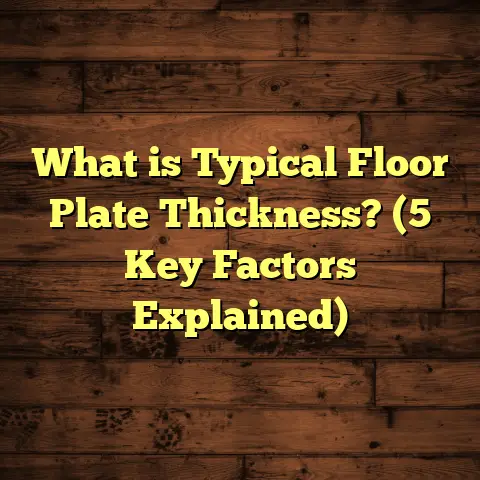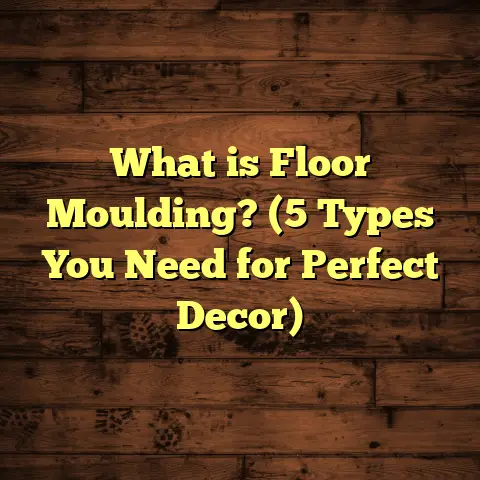What is Floor Heaving? (5 Signs You Need to Know Now!)
Did you know that nearly 30% of homeowners who experience flooring problems report floor heaving as the culprit? I’ve been in the flooring business for over 15 years, and let me tell you, floor heaving is one of those issues that can quietly creep up and wreck your day — or your home — if you don’t catch it early. Over the years, I’ve learned a lot about what causes floor heaving, how to spot the warning signs, and most importantly, how to deal with it effectively. If you’ve ever felt a bump underfoot or noticed cracked tiles for no obvious reason, this is for you.
Let’s get into the nitty-gritty of floor heaving — what it is, why it happens, how to identify it, and what you can do to prevent or fix it — all sprinkled with some real stories from my work.
What Is Floor Heaving?
Floor heaving happens when a section of your floor lifts or rises unevenly — often suddenly — creating bumps, cracks, or uneven surfaces. This isn’t just about an ugly floor or a little inconvenience. It can mess with the structural integrity of your home’s foundation and flooring system.
Usually, this happens because something underneath your floor is pushing upward. That “something” is typically soil or moisture expanding beneath the slab or subfloor, literally forcing your flooring to rise out of place.
I remember one job where the client called me because their living room floor felt “funny.” When I came out to inspect, I found a raised section that was nearly two inches higher than the rest of the floor. That’s not just uncomfortable — that’s dangerous.
How Floor Heaving Works
The key culprit behind floor heaving is pressure. Pressure from below pushes against the flooring materials. This pressure can come from several sources:
- Expansive Soils: Certain soils like clay absorb water and expand in volume. When they swell, they push up the foundation and floors above.
- Frost Heave: In cold climates, water in soil freezes and expands by about 9%. This expansion pushes upwards against slabs and foundations.
- Water Saturation: Poor drainage or leaks saturate soil beneath your home, causing it to swell.
- Root Growth: Roots from nearby trees can grow under slabs and push them up.
- Improper Installation: Floors installed without proper moisture barriers or with inadequate soil prep are more vulnerable.
This upward movement disturbs the flooring surface — concrete slabs crack or lift, tiles pop loose, wood floors buckle.
Types of Floors Affected
Floor heaving isn’t limited to one type of flooring. Here’s what I’ve seen over time:
- Concrete Slab Floors: Most prone to heaving because soil expansion directly pushes on the slab.
- Tile Floors: Tiles are rigid and brittle; when the slab beneath moves, tiles crack or become loose.
- Wooden Floors: Subfloors can lift or warp from soil movement below.
- Laminate and Vinyl: These can buckle or separate if the underlying subfloor moves.
Why Does Floor Heaving Happen?
I want to share some of the most common causes I’ve encountered during my work. Knowing these will help you understand if your home might be at risk.
Soil Types and Their Role
Not all soils are created equal. Some soils are notorious for causing floor heaving. For example:
- Clay Soil: This soil type absorbs water like a sponge and expands significantly. When it dries out, it shrinks back down. This cycle causes constant movement under your home. In fact, according to the U.S. Geological Survey, clay soils can expand by up to 12% in volume when wet. That expansion can exert pressures ranging from 4,000 to 6,000 pounds per square foot on foundations! Years ago, I worked on a home built directly on clay soil with no moisture barrier. After a heavy rainy season, the floors started heaving. We had to do extensive repairs including soil stabilization.
- Silty Soil: Holds more water than sand but less than clay. It can cause moderate expansion and contraction.
- Sandy Soil: Does not retain water well and generally causes fewer problems with heaving but may lead to settling instead.
Frost Heave Explained
If you live somewhere with freezing winters, frost heave could be your enemy.
Frost heaving occurs when water trapped in soil freezes and expands beneath the foundation. The expansion pushes the slab upwards.
Here’s an interesting fact: Frozen water expands about 9% in volume as it turns to ice. This expansion can lift concrete slabs by several inches in some cases.
I once worked on a house in Minnesota where frost heave lifted parts of a basement slab by over 3 inches! The homeowners couldn’t open their basement doors properly until we fixed it.
Poor Drainage
Water is the main driver behind soil expansion. If water pools around your foundation due to poor drainage or leaking pipes, it saturates soil under your slab and causes swelling.
You might not think about drainage much until you start noticing floor problems.
In one project in Texas, improper grading caused water to collect near the foundation after rainstorms. That saturated soil created enough pressure to lift part of the concrete slab by an inch.
Tree Roots
Trees look beautiful but their roots can be a hidden source of trouble.
Roots seek moisture and often grow under foundations if they’re close enough. As roots expand in diameter over time, they push against slabs causing movement.
I’ve seen clients with expensive hardwood floors that started warping because tree roots grew beneath their house over 10 years.
Installation Mistakes That Lead to Heaving
Finally, not all floor heaving is natural — sometimes it’s caused by poor installation practices:
- Failing to install vapor barriers under concrete slabs
- Skipping proper soil compaction before pouring foundations
- Ignoring local soil conditions that require special foundation designs
- Neglecting drainage systems around the home
These shortcuts may save money upfront but cause headaches later.
Five Signs You Need To Know Now
Let me share five signs I’ve learned that indicate your floor might be heaving right now.
1. Uneven or Bumpy Floors
This is the easiest one to spot when walking through your house.
If your floor feels like it’s rolling up or down underfoot or if you notice visible bumps or dips, that’s a warning sign.
I often tell clients: “If you feel like you’re walking uphill indoors — that’s bad.”
In a condo project I managed in California, tenants complained about uneven floors in their kitchens. After inspection, we discovered small areas of slab heave caused by expansive clay soils below.
2. Cracked Tiles or Concrete
Tiles are unforgiving. When the slab beneath them moves even slightly, tiles crack along grout lines or pop off entirely.
In bathrooms and kitchens where tile floors are common, cracks can spread quickly once heaving starts.
One homeowner I worked with ignored cracked tiles for months until water seeped into gaps causing mold issues below.
3. Doors and Cabinets Not Closing Properly
When floors lift unevenly, door frames and cabinetry can shift out of alignment.
Have you ever noticed doors sticking or cabinets that don’t close all the way? Sometimes this is blamed on humidity changes but often it’s due to structural shifts like floor heave.
Several clients have told me their first clue was doors jamming unexpectedly — a subtle but important sign.
4. Gaps Between Walls and Floors
Gaps opening up between baseboards and floors often show that a section of floor has lifted away from walls due to movement below.
During an inspection in Colorado, I saw large gaps appearing where walls met floors caused by frost heave lifting part of the slab foundation underneath.
This kind of separation also risks drafts and pest entry points if left unattended.
5. Cracks in Walls or Foundation
Wider structural cracks near the base of walls or foundation can indicate pressure from floor movement below transmitting into your home structure.
One case I handled involved drywall cracks forming just above baseboards — a sign that foundation shifting was causing stress on framing members.
What Happens If You Ignore Floor Heaving?
Ignoring floor heaving doesn’t make it go away — it gets worse over time.
Here’s what I’ve seen:
- Cracks become larger and more widespread
- Flooring materials like tile or hardwood eventually fail
- Doors and windows jam permanently
- Structural damage spreads causing costly repairs
- Safety hazards develop due to uneven surfaces
I once met a homeowner who waited years before addressing a small bump under their kitchen tile floor. Eventually, it caused enough damage that they had to replace the entire concrete slab plus flooring — cost running into tens of thousands of dollars!
What Can You Do About Floor Heaving?
I always recommend acting as soon as you suspect floor heaving to avoid escalating costs.
Here’s how I approach it:
Step 1: Get a Professional Inspection
Sometimes what looks like floor heaving might be something else — settling or poor installation issues for example.
A professional inspection helps identify root causes using tools like moisture meters, soil probes, and structural analysis.
During inspections, I often take soil samples near foundations to check moisture content and composition.
Step 2: Fix Drainage Issues
Water control is the cheapest and most effective way to prevent further soil expansion pushing on floors.
Make sure:
- Gutters are clean and direct water away
- Ground slopes away from your foundation (minimum slope of 6 inches over first 10 feet)
- French drains or sump pumps are installed if needed
- No leaks exist in underground plumbing
I helped one homeowner install a drainage system around their house which stopped further heaving completely within one season!
Step 3: Repair Heaved Floors
Depending on severity:
- Small raised sections in concrete can be ground down
- Tiles can be replaced after stabilizing slab
- Slab jacking (injecting grout or foam beneath slab) can lift lowered sections back into level position
- Sistering joists or adding blocking supports wooden floors
Slab jacking is a favorite method I use for moderate slab lifting because it avoids demolition and replacement costs.
Step 4: Prevent Future Problems
After repairs:
- Maintain landscaping so water flows away from house
- Monitor moisture levels around foundation regularly
- Avoid planting large trees close to foundations
- Consider waterproofing membranes under slabs during renovations
Installation Tips To Avoid Floor Heaving Problems
If you’re building new or renovating floors, here are some tips from my experience:
- Soil Testing: Have soils professionally tested for expansion potential before construction.
- Moisture Barriers: Install vapor barriers under concrete slabs.
- Proper Soil Compaction: Compact soil thoroughly before pouring slabs.
- Add Gravel Layers: Gravel helps improve drainage below slabs.
- Select Flexible Flooring: Engineered wood or vinyl handle slight movement better than tile.
- Leave Expansion Gaps: Allow space between flooring edges and walls.
- Drainage Systems: French drains or sump pumps prevent water buildup near foundations.
One builder told me they lost thousands fixing floors because they skipped soil compaction steps during construction.
Maintenance Tips To Keep Floors Safe From Heaving
Even after installation:
- Check for early warning signs regularly
- Clean gutters every season
- Repair plumbing leaks immediately
- Maintain consistent indoor humidity levels (especially wood floors)
- Avoid planting large trees near foundations
Case Studies From My Projects
Case Study 1: Frost Heave Rescue In Minnesota
A client’s basement slab lifted nearly three inches due to frost heave after a brutal winter. Doors wouldn’t open properly; tile cracked everywhere.
We performed polyurethane foam injection beneath slab sections which lifted them back into place without major demolition. The job took two days but saved thousands compared to full replacement.
Case Study 2: Clay Soil Expansion In Texas
Heavy rains saturated clay soils causing expansion beneath a home’s slab foundation. Floors upstairs buckled slightly due to shifting joists below.
We improved exterior drainage with French drains and reinforced joists with sister beams for extra support. Client reported no further issues after one year follow-up.
Case Study 3: Tree Root Damage In Oregon
A large oak tree grew roots beneath a home causing localized lifting of wooden subfloor joists leading to warped hardwood floors upstairs.
We removed problematic roots carefully with arborists’ help then added blocking supports between joists for stability. Hardwood was refinished after leveling.
Data & Statistics To Consider
Some numbers worth knowing:
- Homes built on expansive soils have 25% higher chance of developing floor heaving within 10 years without proper measures (Source: U.S. Soil Survey).
- Nearly 40% of foundation repairs reported by National Association of Home Builders relate directly to soil movement causing floor lifting/cracking.
- Frost heave effects are most common in northern U.S., Canada & parts of Europe where freezing winters occur regularly.
This data shows how widespread this issue is — yet many homeowners remain unaware until damage occurs.
Personal Tips For Homeowners
From my years working in flooring repair and installation:
- If you feel unevenness underfoot or see cracks appearing suddenly — don’t wait!
- Take photos regularly if you suspect problems so you can track changes over time.
- Ask your contractor about local soil conditions before starting any major project.
- Trust professional inspections even if it costs a bit upfront — saves money later.
Frequently Asked Questions About Floor Heaving
Q: Can I fix floor heaving myself?
A: Minor issues like small cracks might be DIY-friendly but major slab movement needs professional help due to complexity and safety concerns.
Q: How long does floor heaving repair take?
A: Depends on severity — simple grinding takes hours; slab jacking or drainage improvements may take days.
Q: Will fixing drainage alone stop floor heaving?
A: It prevents further damage but existing heaved areas usually require repair too.
Q: Is floor heaving covered by insurance?
A: Usually not unless caused by sudden events like flooding; check your policy specifics.
Floor heaving is tricky because it often starts small but grows into expensive problems fast if ignored. The good news? With careful monitoring, proper maintenance, and timely repairs, you can keep your floors stable and safe for years to come.
Have you ever noticed signs of floor movement in your home? Got questions about what might cause it where you live? Just ask — I’m happy to share what I know!





